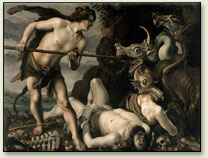Christianity
Medieval minesongs described green as the color of love, on the other hand it also represented demons and evil serpents. Dragon had a positive connotation in the philosophy of ancient Chinese where it represented divine power of change and supernatural wisdom and strength. Thus it was often associated with the color green. This positive symbol was reversed in Christianity and the dragon became a monster of evil and destructive powers. Christian demons were green-skinned and green-eyed dragon-like creatures spitting deadly venom and emanating the smell of Hell. Fertility and with it color green became suspicious as possible effects of unrestrained sexuality. The Devil hunting lost souls was wearing a green frock.
Association of both green and yellow with the concept of poison has not been fully abandoned until today, even if some medieval painters did use green pigments for painting the Cross or draperies of saints as a symbol of hope.
Discovery of the pigment emerald (Schweinfurt green) in 1800 further worsened the repute of green as the color of poison. Emerald was prepared from verdigris and copper arsenite to result in one of the deadliest poisons ever used in painting. Green was the favourite color of Napoleon and the green wallpaper in his exile home in St. Helena became his undoing. His premature death was not the work of a poisoner but was caused by the noxious fumes emanating from the bright green wallpaper.
The connotation of green as the color of hope and renewal, however, has been maintained in Christianity till our times. Green is the color of sundays and the altars in catholic churches are decorated with a green cloth on such days. Christ was depicted in old paintings wearing red and Mary usually wore blue draperies, whereas the Holy Ghost was often shown as a white pigeon on green background.
Establishment of the Green Party in Germany in 1980 brought this color into politics. Green refers to the protection of the environment as the main tenet of the party. White and red in the Italian flag are the ancient colors of Italy, whereas green stands for the right of Freedom and for Equality. This flag was designed by Italian republicans during French Revolution in 1795. Green is the national color of Irish catholics as opposed to orange as the color of the protestant Orangemans who conquered Ireland led by William of Orange.
Islam and the Arabic world
Green is the color of the prophet Mohammed who himself declared it his favourite color and who’s cloak and turban were green. Even today only his direct successors - the Kaliphs - are allowed to wear a green turban. The Holy Banner - the most precious relic of Islam - is green with golden embroidery. Mohammed supposedly carried this very banner into the holy war which resulted in conquering Mecca. Green is also the predominating color in Paradise where it stands for flowery fields and eternal oases. Green is the color of the Arabic League and many Arabic countries have included green in their national flags as it symbolizes the unity of all arabic nations. Green is also the life-giving color of all desert peoples.
The significance of the color green in the Arabic world is even older than Mohammed. The legendary Islamic saint al-Chadir meaning the Green Man leading Nomads of the desert towards water and accompanying travelers on their way. The legend describes the journey of al Chadir through the Land of Darkness until he arrived at a bright white rock. All other travelers were thrown down from this rock but al-chadir was allowed to ascend and reach the "Source of Life". After drinking the precious water his cloak became green and he reached immortality.
(main greens page) - Azurite - verdigris - Emerald green - malachite - viridian - copper resinate - Cobalt green - Green earth

